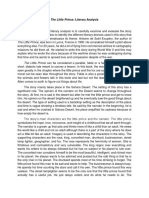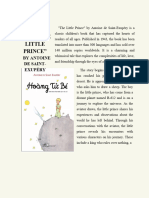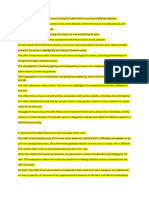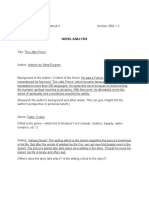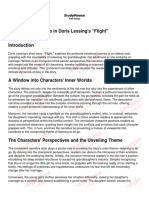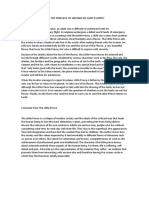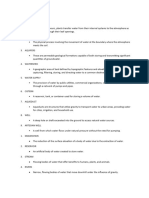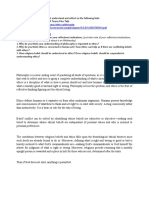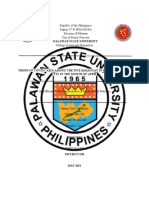Chapter 1 and 2
Chapter 1 and 2
Uploaded by
Raven Jay MagsinoCopyright:
Available Formats
Chapter 1 and 2
Chapter 1 and 2
Uploaded by
Raven Jay MagsinoCopyright
Available Formats
Share this document
Did you find this document useful?
Is this content inappropriate?
Copyright:
Available Formats
Chapter 1 and 2
Chapter 1 and 2
Uploaded by
Raven Jay MagsinoCopyright:
Available Formats
Sequence of Events in Chapter 1 of "The Little Prince":
The protagonist recalls a memory from when he was six years old and saw a picture of a
boa constrictor in a book
He draws a picture of a boa constrictor digesting an elephant, but the grown-ups mistake
it for a hat
The protagonist draws the inside of a boa constrictor to explain his original drawing, but
the grown-ups still fail to understand
The grown-ups advise the protagonist to focus on traditional subjects
like geography, history, arithmetic, and grammar instead of drawing
The protagonist gives up on his career as a painter and decides to become a pilot
He reflects on his encounters with grown-ups and their lack of understanding
The protagonist describes his attempts to find someone who understands his drawing,
but everyone mistakes it for a hat
Literary Analysis/Interpretation:
In Chapter 1 of "The Little Prince," the protagonist reflects on a formative childhood experience
that shaped his perspective on the world. The misunderstanding of his drawing by the grown-
ups serves as a metaphor for the broader theme of miscommunication and the disconnect
between adults and children. Emphasizes the protagonist's belief that the grown-ups lack the
ability to see beyond the surface and understand the deeper meaning of things.
The frustration and disillusionment experienced by the protagonist reflect the author's
commentary on the limitations of adult perception and the importance of maintaining a childlike
sense of wonder and imagination. This chapter sets the stage for the protagonist's journey to
different planets and encounters with various characters, each representing different aspects of
adult behavior and attitudes.
The protagonist's decision to become a pilot and his reflections on the value of geography and
practical knowledge highlight the contrast between the imaginative, intuitive perspective of a
child and the pragmatic, rational approach of an adult. This juxtaposition sets the groundwork
for the exploration of deeper themes related to human nature, relationships, and the search for
meaning throughout the rest of the story.
Sequence of Events in Chapter 2 of "The Little Prince":
The protagonist's plane crashes in the Sahara Desert
He struggles to repair his plane and survive in the harsh desert environment
The protagonist encounters the little prince, who asks him to draw a sheep
The little prince shares stories about his life on his home planet and his encounters with
various inhabitants
The little prince reveals his affection for a rose on his planet and his decision to leave in
search of new experiences
The protagonist and the little prince form a bond as they navigate the challenges of the
desert together
Literary Analysis/Interpretation:
Chapter 2 of "The Little Prince" introduces the protagonist's encounter with the enigmatic little
prince, marking a significant turning point in the story. The harsh, unforgiving environment of
the Sahara Desert serves as a backdrop for the meeting, emphasizing the theme of survival and
resilience in the face of adversity.
The little prince's request for a drawing of a sheep and his subsequent revelations about his life
and experiences on his home planet provide insight into his character and the complex emotions
he grapples with. His affection for the rose and his decision to embark on a journey in search of
meaning and understanding resonate with universal themes of love, longing, and the quest for
fulfillment.
The bond that forms between the protagonist and the little prince amid the challenges of the
desert underscores the transformative power of human connections and the potential for
profound relationships to emerge in unexpected circumstances. This chapter sets the stage for
the exploration of deeper philosophical themes related to human nature, existentialism, and the
pursuit of meaning and purpose.
The juxtaposition of the vast, desolate desert with the intimate, personal stories shared by the
little prince serves to highlight the contrast between external hardships and internal emotional
landscapes, inviting readers to contemplate the universal human experiences that transcend
physical boundaries.
You might also like
- Iec 61724 1 2021Document15 pagesIec 61724 1 2021Loyel RoseNo ratings yet
- CIBSE Guide B2 2016 - Ventilation & DuctworkDocument161 pagesCIBSE Guide B2 2016 - Ventilation & Ductworkpsriariyanan100% (1)
- Physics Project ProjectileDocument16 pagesPhysics Project ProjectileDIPESH BHUSAL80% (5)
- (Extended Essay) Essay About Lord of The FliesDocument17 pages(Extended Essay) Essay About Lord of The FliesGian FrancoNo ratings yet
- The Little Prince Book ReviewDocument12 pagesThe Little Prince Book ReviewJhansen RamosNo ratings yet
- The Little Prince Literary AnalysisDocument2 pagesThe Little Prince Literary AnalysisWesley Lim0% (1)
- 01 - SRV02 QUARC Integration - Instructor ManualDocument21 pages01 - SRV02 QUARC Integration - Instructor ManualFernando Her R0% (2)
- Task 1 - The Story of The Little PrinceDocument6 pagesTask 1 - The Story of The Little PrinceTroJaf OfficialNo ratings yet
- Literary Analysis 1Document2 pagesLiterary Analysis 1Rolland Ray MendozaNo ratings yet
- Exploring The Universe of Childhood (The Little Prince)Document2 pagesExploring The Universe of Childhood (The Little Prince)vicente valenzuelaNo ratings yet
- The Little Prince - Theme and SymbolDocument4 pagesThe Little Prince - Theme and SymbolHatsuharu Hamano0% (1)
- The Little Prince Essay ThesisDocument5 pagesThe Little Prince Essay Thesisebonybatesshreveport100% (2)
- The Little PrinceDocument8 pagesThe Little PrinceKatty GarciaNo ratings yet
- Review of The BookDocument3 pagesReview of The BookNguyễn Minh ThưNo ratings yet
- RWS Draft-WPS OfficeDocument7 pagesRWS Draft-WPS OfficeMinato NamekazeNo ratings yet
- Book - Review - Draft - Template 1Document3 pagesBook - Review - Draft - Template 1torrechivaallenbryanNo ratings yet
- In 200-500 Words, Explain Which Book Has Inspired You The Most and Why? Describe Which Character You Relate To and What You Learned From This BookDocument1 pageIn 200-500 Words, Explain Which Book Has Inspired You The Most and Why? Describe Which Character You Relate To and What You Learned From This BookFernanda PolachiniNo ratings yet
- Task 4 - Illustrating Psychoanalytic CriticismDocument9 pagesTask 4 - Illustrating Psychoanalytic CriticismTroJaf OfficialNo ratings yet
- Book Review (Little Prince)Document2 pagesBook Review (Little Prince)John Darel Langitan Ediong0% (1)
- Bhagya WordDocument7 pagesBhagya WordANUSHA RangollaNo ratings yet
- THE LITTLE PRINCE GROUP TASKS AnsweredDocument13 pagesTHE LITTLE PRINCE GROUP TASKS AnsweredLouiseCuentoNo ratings yet
- De Saint Exupery, Discuss How Each Review Is PresentedDocument10 pagesDe Saint Exupery, Discuss How Each Review Is PresentedJenna LimNo ratings yet
- The Little Prince (RWS)Document2 pagesThe Little Prince (RWS)Minato NamekazeNo ratings yet
- Cream Brown Simple Aesthetic Paper Border - 20240404 - 192946 - 0000Document3 pagesCream Brown Simple Aesthetic Paper Border - 20240404 - 192946 - 0000jdl124131130040No ratings yet
- Cream Brown Simple Aesthetic Paper Border - 20240404 - 193152 - 0000Document3 pagesCream Brown Simple Aesthetic Paper Border - 20240404 - 193152 - 0000jdl124131130040No ratings yet
- Novel Analysis - The Little PrinceDocument5 pagesNovel Analysis - The Little PrinceDaniNo ratings yet
- Who Are The Main Characters? Give The Characteristics of Each Character. How Relevant Are The Characters in The Story?Document6 pagesWho Are The Main Characters? Give The Characteristics of Each Character. How Relevant Are The Characters in The Story?Jemarjo SalandananNo ratings yet
- Ayushi Jain - 1064 - The Little PrinceDocument6 pagesAyushi Jain - 1064 - The Little PrincepankhuriNo ratings yet
- A Book Review - Little PrinceDocument5 pagesA Book Review - Little PrinceRyan Mangundayao La RosaNo ratings yet
- Book Report: "The Little Prince"Document5 pagesBook Report: "The Little Prince"Sophia Nichole ContrerasNo ratings yet
- The Little PrinceDocument4 pagesThe Little Princenirali.saraf2016No ratings yet
- Crafting the Perfect Backdrop: A Comprehensive Guide for AuthorsFrom EverandCrafting the Perfect Backdrop: A Comprehensive Guide for AuthorsNo ratings yet
- 1Document7 pages1drenevisNo ratings yet
- Questions of NovelDocument2 pagesQuestions of NovelSaraw4840No ratings yet
- Thesis Statement The Little PrinceDocument4 pagesThesis Statement The Little PrincePaperWriterServicesUK100% (2)
- Important Symbols and Motifs ofDocument1 pageImportant Symbols and Motifs ofTricky StarNo ratings yet
- The Little Prince PPT 2 220902024742 25409eedDocument24 pagesThe Little Prince PPT 2 220902024742 25409eedbogdanshev1216No ratings yet
- Novel AnalysisDocument5 pagesNovel AnalysisMark Joshua CequeñaNo ratings yet
- BAEL, CHARACTER ANALYSISsssDocument1 pageBAEL, CHARACTER ANALYSISsssjhonrhoy.baelNo ratings yet
- English 10 Book Review: The Little PrinceDocument4 pagesEnglish 10 Book Review: The Little PrinceLenard RosasNo ratings yet
- GeneralizationDocument2 pagesGeneralizationMary Rose Abit GoNo ratings yet
- Journey To The Heart A Reflection On The Little PrinceDocument1 pageJourney To The Heart A Reflection On The Little PrinceYves De PazNo ratings yet
- Borata, Ellen Rose O. Chapter Summary (I-Iii)Document1 pageBorata, Ellen Rose O. Chapter Summary (I-Iii)Eka EkaNo ratings yet
- ReactionPaper - The Little PrinceDocument2 pagesReactionPaper - The Little PrinceAbegail Adolfo AblanzarNo ratings yet
- THe Man Who Loved IslandsDocument4 pagesTHe Man Who Loved IslandsKJF Pro100% (1)
- Rufo 05 Performance Task Final - ARGDocument10 pagesRufo 05 Performance Task Final - ARGセイロバ ウティスタNo ratings yet
- Teaching and Assessment of Literature StudiesDocument4 pagesTeaching and Assessment of Literature StudiesriaglrtcdNo ratings yet
- The Little Prince by Antoine de Saint-Exupéry (Book Analysis): Detailed Summary, Analysis and Reading GuideFrom EverandThe Little Prince by Antoine de Saint-Exupéry (Book Analysis): Detailed Summary, Analysis and Reading GuideRating: 1 out of 5 stars1/5 (1)
- SOLABODocument12 pagesSOLABOSayong , John Mike J.No ratings yet
- Literary CriticismDocument2 pagesLiterary CriticismKrez zel Mae16No ratings yet
- Analysis of Little PrinceDocument7 pagesAnalysis of Little PrinceToby TejaNo ratings yet
- Loneliness Essay of Mice and MenDocument2 pagesLoneliness Essay of Mice and Menb72d994z100% (2)
- The Little PrinceDocument1 pageThe Little PrinceJose VillarealNo ratings yet
- Happy PrinceDocument2 pagesHappy Princepritam duttaNo ratings yet
- Comparative Suicide Vs DeathDocument5 pagesComparative Suicide Vs Deathbryan macbenzNo ratings yet
- Final ProjectDocument5 pagesFinal ProjectbodmasguluNo ratings yet
- Littleprincediscussion QuestionsDocument3 pagesLittleprincediscussion Questionsandrewteacher332No ratings yet
- LPP Ch1 Lesson NotesDocument3 pagesLPP Ch1 Lesson Notesbryann.deenNo ratings yet
- The Death of A NaturalistDocument3 pagesThe Death of A Naturalistsayangh2007No ratings yet
- The Art of Letting Go in Doris Lessing S FlightDocument2 pagesThe Art of Letting Go in Doris Lessing S Flightlehoa0643No ratings yet
- A Book Report On The Story The Little PrinceDocument9 pagesA Book Report On The Story The Little PrinceDezree Lynne RaborNo ratings yet
- Ensayo de Ingles 1Document1 pageEnsayo de Ingles 1jesus perezNo ratings yet
- Chapter IIDocument19 pagesChapter IIAdam AmandaNo ratings yet
- Week-5 21st Century LiteratureDocument30 pagesWeek-5 21st Century LiteratureKaren FalsisNo ratings yet
- Summary of MaterialsDocument4 pagesSummary of MaterialsRaven Jay MagsinoNo ratings yet
- Republic Act 386Document5 pagesRepublic Act 386Raven Jay MagsinoNo ratings yet
- Canopy BistroDocument1 pageCanopy BistroRaven Jay MagsinoNo ratings yet
- Prelim Performance TaskDocument1 pagePrelim Performance TaskRaven Jay MagsinoNo ratings yet
- Chapter 18Document14 pagesChapter 18Raven Jay MagsinoNo ratings yet
- Parking GarageDocument1 pageParking GarageRaven Jay MagsinoNo ratings yet
- Definition PlaDocument2 pagesDefinition PlaRaven Jay MagsinoNo ratings yet
- Chapter 11 and 12 Summary AnalysisDocument2 pagesChapter 11 and 12 Summary AnalysisRaven Jay MagsinoNo ratings yet
- Science MTP#1Document2 pagesScience MTP#1Raven Jay MagsinoNo ratings yet
- Philosophical Questions Introduction 082922Document2 pagesPhilosophical Questions Introduction 082922Raven Jay MagsinoNo ratings yet
- Community Library Case StudyDocument3 pagesCommunity Library Case StudyRaven Jay MagsinoNo ratings yet
- Different Types of Architectural ConceptsDocument3 pagesDifferent Types of Architectural ConceptsRaven Jay MagsinoNo ratings yet
- Ethics and Culture 102322Document3 pagesEthics and Culture 102322Raven Jay MagsinoNo ratings yet
- GED104Document3 pagesGED104Raven Jay MagsinoNo ratings yet
- Basic Concepts of Ethics 091722Document8 pagesBasic Concepts of Ethics 091722Raven Jay MagsinoNo ratings yet
- Class 6 Sample Questions: International Olympiad of Science - iOS' 19Document1 pageClass 6 Sample Questions: International Olympiad of Science - iOS' 19Aaditya100% (1)
- BSCPH 102Document11 pagesBSCPH 102Umar MirNo ratings yet
- NIC - Betacyanin To Semen SmearDocument6 pagesNIC - Betacyanin To Semen SmearNicole Jane RobesNo ratings yet
- Food Science and Human Nutrition: Undergraduate StudyDocument17 pagesFood Science and Human Nutrition: Undergraduate StudyMulubrhan OkbaiNo ratings yet
- Energy Mastery BookletDocument21 pagesEnergy Mastery Bookletapi-422428700No ratings yet
- Microplastics in The Environment: Impact On Human Health and Future Mitigation StrategiesDocument5 pagesMicroplastics in The Environment: Impact On Human Health and Future Mitigation StrategiesThy LeNo ratings yet
- Assignment: Project ManagementDocument8 pagesAssignment: Project ManagementnikhilNo ratings yet
- Chapter 6 - Reviewing The LiteratureDocument14 pagesChapter 6 - Reviewing The LiteratureAiman Padilla AbreuNo ratings yet
- University, Jordan.: Rafe'a Al-Zghoul, Department of Curriculum and Instruction, YarmoukDocument13 pagesUniversity, Jordan.: Rafe'a Al-Zghoul, Department of Curriculum and Instruction, YarmoukRayan dmNo ratings yet
- Unintentional Passive CommunicationDocument3 pagesUnintentional Passive CommunicationConnieChenNo ratings yet
- Nerpan Bismillahbarua5 Hal 21Document55 pagesNerpan Bismillahbarua5 Hal 21Roni SetiawanNo ratings yet
- Seal of Good Local Governance - NATIONAL VALIDATIONDocument5 pagesSeal of Good Local Governance - NATIONAL VALIDATIONMPDO LGU HERMOSANo ratings yet
- Plato's Allegory of The CaveDocument5 pagesPlato's Allegory of The CaveMarianne NolascoNo ratings yet
- Chapter 1 Complete Updated Lyst1896Document36 pagesChapter 1 Complete Updated Lyst1896bhatiasrishti744No ratings yet
- English: Quarter 2 - Module 7: A Venture To The Wonders of Reading and ListeningDocument32 pagesEnglish: Quarter 2 - Module 7: A Venture To The Wonders of Reading and ListeningMercy GanasNo ratings yet
- BUS 6001 - Case Analysis 30 MarksDocument3 pagesBUS 6001 - Case Analysis 30 MarksgloriachebetkoskeiNo ratings yet
- Chineseburned AWADocument7 pagesChineseburned AWAsureshk143100% (1)
- Crocodylus Acutus, American CrocodileDocument32 pagesCrocodylus Acutus, American CrocodilePierreNo ratings yet
- How To Write A Title Page For A Term PaperDocument8 pagesHow To Write A Title Page For A Term Paperea4hasyw100% (1)
- Palawan State UniversityDocument20 pagesPalawan State UniversityMengmeng GinfabNo ratings yet
- BORAL Fly Ash Class F Brochure 7 10 19Document4 pagesBORAL Fly Ash Class F Brochure 7 10 19Abdulrahman Tawfik SerorNo ratings yet
- Catalog Vinallum AluminiumDocument12 pagesCatalog Vinallum AluminiumArifin MasruriNo ratings yet
- IPC 1 Foundation v2Document28 pagesIPC 1 Foundation v2Law Zi YanNo ratings yet
- Week 4 MATHDocument5 pagesWeek 4 MATHCharles lbaoNo ratings yet
- Lab 4 - Tubular Flow Reactor - ManuscriptDocument8 pagesLab 4 - Tubular Flow Reactor - ManuscriptppppNo ratings yet
- GE 5 Mathematics in The Modern WorldDocument31 pagesGE 5 Mathematics in The Modern Worldstephaniejeancortez522No ratings yet





